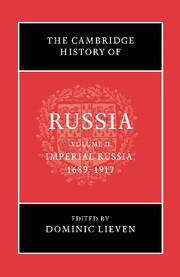Book contents
- Frontmatter
- Introduction
- Part I Empire
- Part II Culture, Ideas, Identities
- Part III Non-Russian Nationalities
- Part IV Russian Society, Law and Economy
- 11 The elites
- 12 The groups between: raznochintsy, intelligentsia, professionals
- 13 Nizhnii Novgorod in the nineteenth century: portrait of a city
- 14 Russian Orthodoxy: Church, people and politics in Imperial Russia
- 15 Women, the family and public life
- 16 Gender and the legal order in Imperial Russia
- 17 Law, the judicial system and the legal profession
- 18 Peasants and agriculture
- 19 The Russian economy and banking system
- Part V Government
- Part VI Foreign Policy and the Armed Forces
- Part VII Reform, War and Revolution
- Bibliography
- Index
- Map 5. The Russian Empire (1913). From Archie Brown, Michael Kaser, and G. S. Smith (eds.) Cambridge Encyclopedia of Russia 1982.">
- Plate Section">
- References
12 - The groups between: raznochintsy, intelligentsia, professionals
from Part IV - Russian Society, Law and Economy
Published online by Cambridge University Press: 28 March 2008
- Frontmatter
- Introduction
- Part I Empire
- Part II Culture, Ideas, Identities
- Part III Non-Russian Nationalities
- Part IV Russian Society, Law and Economy
- 11 The elites
- 12 The groups between: raznochintsy, intelligentsia, professionals
- 13 Nizhnii Novgorod in the nineteenth century: portrait of a city
- 14 Russian Orthodoxy: Church, people and politics in Imperial Russia
- 15 Women, the family and public life
- 16 Gender and the legal order in Imperial Russia
- 17 Law, the judicial system and the legal profession
- 18 Peasants and agriculture
- 19 The Russian economy and banking system
- Part V Government
- Part VI Foreign Policy and the Armed Forces
- Part VII Reform, War and Revolution
- Bibliography
- Index
- Map 5. The Russian Empire (1913). From Archie Brown, Michael Kaser, and G. S. Smith (eds.) Cambridge Encyclopedia of Russia 1982.">
- Plate Section">
- References
Summary
Beginning in the eighteenth century, when regularised bureaucracy struck deep roots in imperial Russia, policy-makers struggled to visualise the middle layers of Russian society. The vast geographical reaches of the empire, the cultural diversity of its population and the absence of constituted political bodies made it difficult to define the social groups situated between the mass of peasant cultivators and the governing classes of noble landowners, civil servants and military officers. As early as the middle of the seventeenth century Muscovite officials codified the assignment of Russian subjects to legally defined ranks (chiny) that carried specific rights, privileges and obligations to the state. This practice continued in the eighteenth century, when agglomerated social categories (sostoianiia or sosloviia) took shape, and remained a key feature of Russian social organisation until the Bolshevik Revolution of 1917. Sometimes called ‘estates’ by modern-day historians, the Russian sostoianiia consisted of hereditary statuses that functioned both as tools of administration and as social communities. The Russian categories did not play a political role equivalent to that of the French États or German Stände, but they did share important features with these groups. Like corporate groups in Western and Central Europe, Russian nobles, clergy and townspeople enjoyed distinctive hereditary privileges; however, in contrast to the European groups, their privileges were not historically constituted in the local law codes, institutions and offices of identifiable territories. Indeed, at the Russian monarch’s discretion, without the consent of any corporate institution, privileges could be granted or rescinded and obligations redefined.
Keywords
- Type
- Chapter
- Information
- The Cambridge History of Russia , pp. 245 - 263Publisher: Cambridge University PressPrint publication year: 2006
References
- 2
- Cited by

